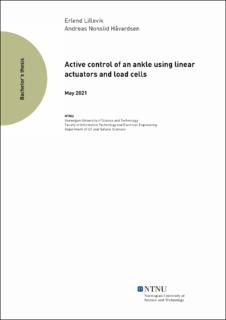Active control of an ankle using linear actuators and load cells
Bachelor thesis
Permanent lenke
https://hdl.handle.net/11250/2782115Utgivelsesdato
2021Metadata
Vis full innførselSamlinger
Sammendrag
Denne rapporten gjelder utviklingen av en prototype for å utføre stabilitetstester på en ankel. Formålet med dette prosjektet er å undersøke hvordan man implementerer et slikt system, og å lage simulering og visualisering av en ankel. Prototypen bruker fire lineære aktuatorer og fire lastceller for å trekke og måle belastningen på en sene. For å gjøre dette ble det laget en ankelmodell med simulerte sener. Resultatene fra testingen av prototypen viser at systemet er i stand til å bevege ankelen i et realistisk bevegelsesmønster og nøyaktig måle belastningen. Prototypen ville imidlertid ha nytte av bedre integrering av programvare og kontroller. Simuleringen og visualiseringen gir en god tilnærming til en ekte ankel. Den bruker imidlertid en forenklet matematisk modell og kan dra nytte av mer optimalisering. Likevel viser prototypen potensiale og fungerte godt som et bevis på konseptet. This report concerns the development of a prototype system to perform stability tests on an an-kle. The purpose of this project is to investigate how to implement such a system, and to make asimulation and visualization of an ankle. The prototype uses four linear actuators and four loadcells to pull and measure the load on a tendon. For this, an ankle model with simulated tendonswas made. The results from testing the prototype show that the system is capable of moving theankle in a realistic movement pattern and accurately measure the load. It would however ben-efit from better software and controller integration. The simulation and the visualization givesa good approximation to a real ankle. It does however use a simplified mathematical modeland could benefit from more optimization. Even still, the prototype shows great promise andworked well as a proof of concept.
